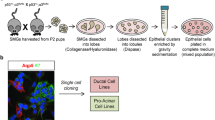Summary
We have successfully maintained and biochemically characterized differentiated rat parotid acinar cells cultured for long periods (6 mo.). The cells were cultured on a reconstituted basement membrane matrix in a medium containing a variety of agents that promote cellular proliferation and differentiation. The cultured cells retain the characteristics of the parental parotid acinar cells. They exhibit both secretory granules and abundant cellular organelles required for protein synthesis and secretion. In situ hybridization and immunocytochemistry demonstrate high levels of proline-rich protein mRNA and protein, and lower levels of amylase mRNA and protein, in their cytoplasm. These findings suggest that rat parotid acinar cells can be maintained in a differentiated state in vitro for long periods, and can serve as a useful model system for studying the regulation of exocrine secretory processes.
Similar content being viewed by others
References
Ann, D. K.; Clements, S.; Johnstone, E. M., et al. Induction of tissue specific proline-rich protein multigene families in rat and mouse parotid glands by isoproterenol. J. Biol. Chem. 262:899–904; 1987.
Baum B. J.; Ambudkar, I. S.; Helman, J., et al. Dispersed salivary gland acinar cell preparations for use in studies of neuroreceptor-coupled secretory events. Methods Enzymol. 192:26–37; 1990.
Baum, B. J.; Levine, R. L.; Kuyatt, B. L., et al. Rat parotid gland amylase: evidence for alterations in an exocrine protein with increased age. Mech. Ageing Develop. 19:27–35; 1982.
Bernfeld, P. Amylases,α andβ. Methods Enzymol. 1:149–157; 1955.
Bradford, M. A rapid and sensitive method for the quantitation of microgram quantities of protein utilizing the principle of protein-dye binding. Anal. Biochem. 72:248–254; 1976.
Brown, A. M.; Rusnack, E. J.; Sciubba, J. J., et al. Establishment and characterization of an epithelial cell line from the rat submandibular gland. J. Oral. Pathol. Med. 18:206–213; 1989.
Butcher, F. R.; Putney, J. W. Regulation of parotid gland function by cyclic necleotides and calcium. Adv. Cyclic Nucleotides Res. 13:215–249; 1980.
Cook, D. I.; Poronnik, P.; Young, J. A. Characterization of a 25-pS nonselective cation channel in a cultured secretory epithelial cell line. J. Membr. Biol. 114:37–52; 1990.
Fahimi, H. D. Cytochemical localization of peroxidatic activity of catalase in rat hepatic microbodies (peroxisomes) J. Cell. Biol. 43:275–288; 1969.
Hatakeyama, S.; Sashima, M.; Tsushima, T., et al. Immunohistochemical demonstration of amylase in normal and neoplastic salivary glands. Jpn. J. Oral Biol. 27:702–708; 1985.
Herkenham, M.; Pert, C. B. Light microscopic localization of brain opiate receptors: a general autoradiographic method preserves tissue quality. J. Neuro. Sci. 2:1129–1149; 1982.
Herkenham, M. Receptor autoradiography: optimizing anatomical resolution. In: Leslie, F. M.; Altar, C. A., eds. Receptor localization: ligand autoradiography, receptor biochemistry and methodology, vol. 43. New York: Alan R. Liss; 1988:37.
Johnson, D. A. Changes in rat parotid salivary proteins associated with liquid diet-induced gland atrophy and isoproterenol induced gland enlargement. Arch. Oral Biol. 29:215–221; 1984.
Kiser, C. S.; Rahemtulla, F., Mansson-Rahemtulla, B. Monolayer culture of rat parotid acinar cells without basement membrane substrates. In Vitro Cell. Dev. Biol. 26:878–888; 1990.
Kleinman, H. K.; McGarvey, M. L.; Hassell, J. R., et al. Basement membrane complexes with biological activity. Biochemistry 25:312–318; 1986.
Kousvelari, E. E.; Baratz, R. S.; Burke, B., et al. Immunochemical identification and determination of proline-rich proteins in salivary secretions, enamel pellicle and glandular tissue specimens. J. Dent. Res. 59:1430–1438; 1980.
Kousvelari, E. E.; Bannerjee, D. K.; Grant, S. R., et al. Modulation of oligosaccharide processing in an exocrine secretory glycoprotein of rat parotid cells byβ-adrenoreceptor activation. Arch. Oral Biol. 33:115–120; 1988.
Laemmli, U. K. Cleavage of structural proteins during the assembly of the head of T4 bacteriophage. Nature 227:680–685; 1970.
Melton, D. A.; Krieg, P. A.; Rebagliati, M. R., et al. Efficientin vitro synthesis of biologically active RNA and DNA hybridization probes from plasmids containing a bacteriophage SP6 promoter. Nucleic Acid Res. 12:7035–7056; 1984.
Oliver, C.; Waters, J. F.; Tolbert, C. L., et al. Growth of exocrine acinar cells on a reconstituted basement membrane gel. In Vitro Cell. Dev. Biol. 23:465–473; 1987.
Oliver, C.; Waters, J. F.; Tolbert, C. L., et al. Culture of parotid acinar cells on a reconstituted basement membrane substratum. J. Dent. Res. 66:594–595; 1987.
Redman, R. S.; Quissell, D. O.; Barzen, K. A. Effects of dexamethasone, epidermal growth factor and retinoic acid on rat submandibular acinar-intercalated duct complexes in primary culture. In Vitro Cell. Dev. Biol. 24:734–742; 1988.
Reynolds, E. S. The use of lead citrate at high pH as an electron-opaque stain in electron microscopy. J. Cell. Biol. 17:208–212; 1963.
Schneyer, C. A. Regulation of salivary gland size. In: Goss, R. J., ed. Regulation of organ and tissue growth. New York: Academic Press; 1972:211–323.
Shirasuna, K.; Sato, M.; Miyazaki, T. A neoplastic epithelial duct cell line established from an irradiated human salivary gland. Cancer 48:745–752; 1981.
Author information
Authors and Affiliations
Rights and permissions
About this article
Cite this article
Yeh, CK., Mertz, P.M., Oliver, C. et al. Cellular characteristics of long-term cultured rat parotid acinar cells. In Vitro Cell Dev Biol – Animal 27, 707–712 (1991). https://doi.org/10.1007/BF02633215
Received:
Accepted:
Issue Date:
DOI: https://doi.org/10.1007/BF02633215




